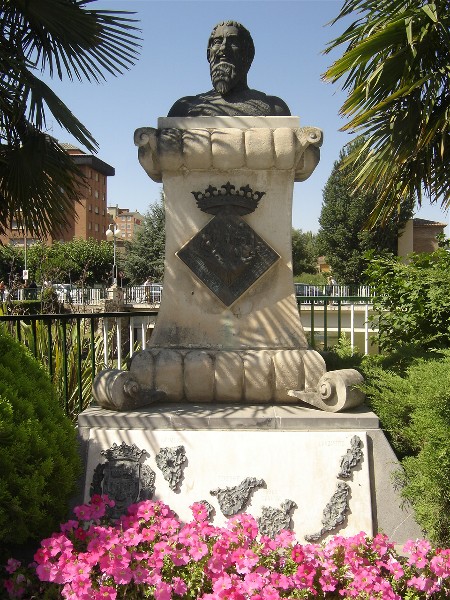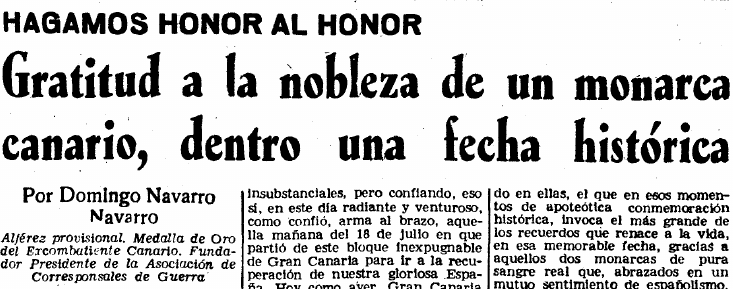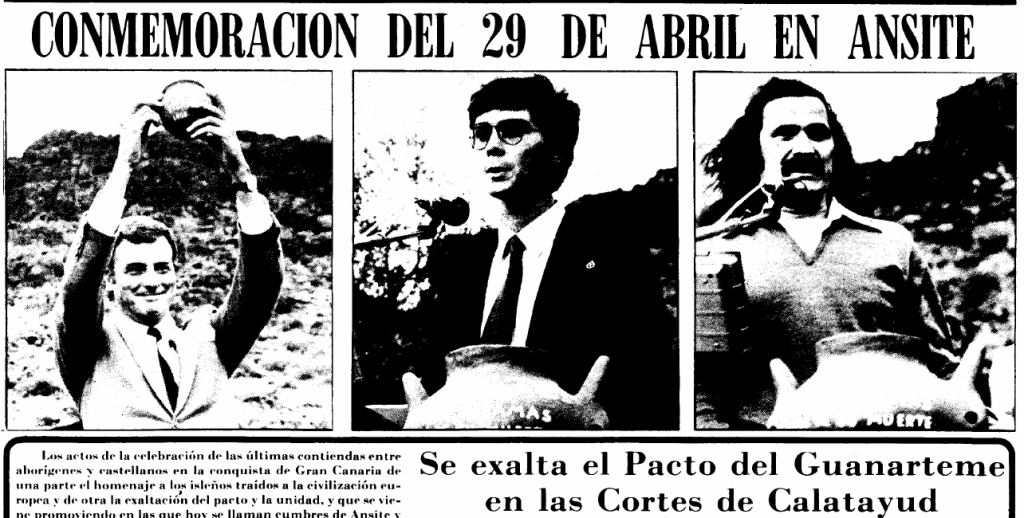
The monument dedicated to Don Fernando Guanarteme at Calatayud (source: Escultura Urbana en Aragón – Armando González Gil).
Professor Wölfel did not imagine that in 1959, almost three decades after publishing his transcription of the Letter of Calatayud in Anthropos journal, a bitter and almost surreal debate of political and intellectual nature was about to begin on account of his discovery.
On April 25th of that year, four days before the ceremony commemorating Gran Canaria’s surrender to the Crown of Castile, journalist Domingo Navarro Navarro, president of Spanish Association of War Correspondents, published in the newspaper Falange an article in which he praised the role played by Fernando Guanarteme in leading ancient Canarians to give in before the Catholic Monarchs, attributing to the island leader the merit of having signed the peace of Calatayud in the year 1481.
Politics and polemics
The matter would not have transcended beyond the publication of another panegyric had it not been the case that the person chosen that year to write and read the proclamation of the celebrations was Professor Antonio Rumeu de Armas, who on the night of April 28th delivered his speech on Radio Las Palmas, appearing published the next morning in the same newspaper Falange.
In his dissertation, avoiding allusions, Professor Rumeu de Armas denied the presence of Fernando Guanarteme in Calatayud, adjudging it to so-called King Pedro instead, whom he identifies with the character called Aymediacoan in some sources, among other variants of the anthroponym:
Finally, the unknown and mysterious King Pedro, neighbor and resident of Gáldar, appears in his full body in 1501, who can be identified with Armide Yacocon, brother of the Guanarteme of Telde Ventagoo and father at one time of the brave Autindana and the graceful and captivating princess Thenesoya Vidina.
[…]
Rendered King Pedro in April of 1481 and being captivated King Fernando in February of 1483, […][1]This translation by PROYECTO TARHA.
On May 30th, Domingo Navarro Navarro announced that, thanks to his efforts, the Town Hall of Calatayud had agreed in extraordinary session to rename Plaza de la Correa, in the Aragonese town, as Plaza de Fernando de Guanarteme. These news were followed by supporting articles signed by Luis Doreste Silva, the Official Chronicler of Las Palmas de Gran Canaria, and Sebastián Jiménez Sánchez, regional delegate of archaeological excavations.
Professor Rumeu de Armas’ answer arrived on July 10th through Diario de Las Palmas, in an article whose title lacked half-measures: Don Fernando de Guanarteme never been to Calatayud. Who appeared in the Aragonese town was another Canarian monarch.[2]This translation by PROYECTO TARHA.
The denial, coming from such a prestigious Professor of History, provoked the outrage of Navarro who prepared his own counter-reply on July 26th in the form of article to full page. This response was followed during more than ten years by a campaign of various initiatives lead by Navarro opposing the reasonable doubts raised by Rumeu de Armas –who came to offer a million pesetas to whom could provide him with some reliable proof of Fernando Guanarteme’s presence in Calatayud–: an edition of a commemorative medal, frequent visits and letters to the consistory of Calatayud, obtaining the consistorial commitment for the placement of a bust of Fernando Guanarteme –sculpted by Emilio Laíz Campos– in the promised square, delivering of soil bags from both Gran Canaria and Toledo to deposit them inside an urn to be part of the monument… a campaign interrupted by the journalist’s passing in April 1973.
The twinning
However, once the homage materialized, it continued its course with the support of experts such as Professor Celso Martín de Guzmán, and although the Calatayud Council eventually reversed the plan to rename Plaza de la Correa, in 1977 the bust dedicated to Fernando Guanarteme was placed in Plaza Islas Canarias, in the heart of Paseo de las Cortes de Aragón.
Four years later, on May 30th, 1981, to celebrate the 500 years of the alleged vassalage of Tenesor Semidan to the Catholic Monarchs, the cities of Calatayud and Gáldar were twinned, granting their respective place-names to local streets.
From the perspective of years, it is surprising the enormous amount of press articles to which the Letter of Calatayud gave rise, of which we have offered here only a small sample. And although today experts like Professor Manuel Lobo Cabrera continue to defend in its general lines the thesis raised by Dr. Rumeu de Armas regarding this issue, the fact is that, once again, the prevalence of that saying which advises not to let reality –doubts, in this case– ruins a good story.
Acknowledgements
This time we would like to thank the personnel at the Biblioteca Insular de Gran Canaria their kindness in providing us with a digital copy of the photocopy of cited article Don Fernando de Guanarteme nunca estuvo en Calatayud, kept as part of the Miguel Santiago Collection, catalogue number MS A2/12.
Our acknowledgement also to the Library of the Universidad de Las Palmas de Gran Canaria for making publicly available their excellent press collections through JABLE Digital Archive, which has facilitated a lot the making of this post.




